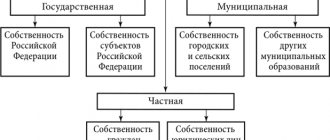Home / Real estate / Land / Ownership
Back
Published: 05/08/2017
Reading time: 16 min
0
1040
If the rights of owners of land plots are violated due to the actions of government officials or civilians, the owners can restore their rights to own land plots only in court.
To do this, you need to draw up a statement of claim, attaching the necessary documents, as well as evidence of attempts to settle the case pre-trial.
- In what cases should you go to court?
- Features of drawing up an application
- Drawing up by a lawyer
- Application Rules
- Submission deadlines
- Legal procedure
- The court's decision
In what cases should you go to court?
Owners of land plots should contact the judicial authorities if necessary to restore lost or infringed rights to their plots.
Ownership rights may be violated in the following cases:
- Termination or slowdown of land privatization procedures by local authorities;
- Illegal termination of registration of a land transaction with Rosreestr authorities;
- The presence of property claims of former spouses against each other;
- Presence of inheritance disputes;
- Loss of title and/or title documentation for the land plot;
- The need for registration of cut-offs;
- Separation of a share of an allotment from joint ownership with violations;
- Illegal arrest or seizure of land from the owner;
- Illegal change of allotment boundaries;
- Purchasing or building housing on land that is not owned.
When registering ownership of a residential building in the private sector, the land under this house also passes to the new owner of the house, in accordance with Art. 35 of the Land Code of the Russian Federation.
If claims arise against the owner of a house for the land under such a house, the owner of the property has the right to go to court to recognize him as the owner of the land under the property.
You should go to court if, as a result of the division of inheritance, marital property or the allocation of a share from the common property, one of the participants in the process received a plot of land less than the area required by law.
Obstruction by the local administration of the legal transfer of land into personal ownership from the state is also a violation of property rights.
Where to start designing a site
To register land as a property if it has been used for more than 20 years, you must start by collecting all the documents that confirm its use. You need to contact the dacha farm or the archives of local authorities for an extract.
The document must indicate:
- when the site was allocated;
- to whom;
- its area and boundaries;
- on the basis of what decision;
- for how long.
After this, land surveying will be required. This is done by specially authorized organizations in the region. The new plan will be entered into the cadastral register. Sometimes there are discrepancies between the latest information and the data already available there. This is acceptable; new information will replace the old one.
A third package of documents will be needed if the land is registered by the user’s heirs. You will need to prove that no other relative or person named in the will has a claim to the property.
Registration of property rights is carried out by the local branch of Rosreestr, where the documents are sent. This is a procedure that does not cause complications. That is, the local archive was not lost or burned, the relatives were unanimous in their decision, and the neighbor did not demand that the fence be moved back 5 cm.
Features of drawing up an application
Before drawing up an application, the owner whose rights have been infringed must identify the defendant (an authorized administration employee or a private individual).
According to paragraph 2 of Art. 125 of the Arbitration Procedural Code of the Russian Federation, a statement of claim to the court must contain the following points:
- The name of the judicial authority to which the claim is sent;
- Representation of the parties;
- Description of the subject of the litigation;
- The plaintiff's claim against the defendant;
- Circumstances of violation of rights to a plot of land;
- Evidence of circumstances;
- Evidence of attempts to pre-trial restoration of allotment rights.
The subject of the legal dispute is a land plot in respect of which the rights of the plaintiff have been violated.
The application shall indicate: the address of the allotment, the cadastral number and characteristics, as well as the numbers of title documents for this allotment.
The submission of the parties for the defendant and the plaintiff should indicate:
- FULL NAME;
- Registration and residence address;
- Date of birth;
- Contact details;
- Place of work;
- Position held.
The plaintiff’s demand should indicate the restoration of the lost right to the land plot or part thereof and list the articles of laws or regulations in accordance with which the plaintiff has the right to own the land.
Then you need to indicate the date of receipt of the plot of land (or receipt of the right to privatization) and list the grounds for such ownership (purchase agreement, conclusion of the executive branch, etc.). Then the actions of the defendant are described, which led to the violation of the plaintiff’s rights to the land plot and their evidence is provided.
It should be remembered that the application will be accepted by the court for consideration only if the plaintiff could not otherwise restore the violated right to the site, therefore the application must list the attempts made by the plaintiff to pre-trial settlement of the dispute and attach evidence of such attempts.
Attempts at pre-trial settlement may include:
- Complaints sent to administrative authorities;
- Claims sent to the defendant;
- Written notice to the defendant of the intention to go to court.
It is important to describe in the application the defendant’s reaction to attempts at pre-trial settlement and attach evidence of ignoring the plaintiff’s demands. Evidence may be witness testimony, written responses to complaints, or refusals to accept claims by authorized bodies.
For example, when allocating a share of a summer cottage plot from joint ownership, the plaintiff must provide the minutes of the meeting of the plot owners and a copy of the appeal to the SNT board as evidence of pre-trial actions.
Drawing up by a lawyer
Drawing up a correct statement of claim to restore rights to a land plot requires experience and knowledge of land legislation.
Law firms provide services to support land claims, which include:
- Initial consultation with a lawyer;
- Formulating a claim;
- Drawing up an application;
- Collection of evidence;
- Filing a claim.
The first three services are basic when contacting lawyers.
At the initial consultation, the specialist clarifies the circumstances of the violation of rights to the site and helps the plaintiff identify the defendant and formulate his demands in the application. The cost of this service varies in different companies from 3 to 6 thousand rubles.
The court may repeatedly return the submitted application to the plaintiff to clarify individual circumstances, provide additional data, etc. Filing an application can also be entrusted to lawyers, but the cost of drawing up an application and the procedure for filing it with the court is at least 10,000 rubles.
Application Rules
In accordance with paragraph 1 of Art. 38 of the Arbitration Procedure Code of the Russian Federation, a statement of claim for the restoration of rights to a plot must be filed with the arbitration court at the address of the location of the subject of the dispute (land plot).
The following documents must be attached to the application:
- A copy of the plaintiff's passport;
- Receipt for payment of state duty;
- Title and title documents for the allotment;
- Cadastral passport of the allotment and boundary plan;
- Technical certificate;
- Certificates and notifications confirming pre-trial actions.
The title document is a certificate of ownership, and title documents are the source of the emergence of such a right, these include purchase agreements, donations, etc.
Depending on the circumstances of the violation of the plaintiff’s rights, additional documents may be required, for example, a certificate of divorce in case of disputes between former spouses or a copy of the will in case of infringement of the rights of the heir to the plot.
To confirm responsible ownership of a plot of land when restoring lost documents, receipts for payment of land tax by the plaintiff should be attached to the statement of claim.
If the right to the land under the house is restored, then you need to present to the court a certificate of ownership of the house or a building permit if the house is being built.
It must be remembered that in accordance with Art. 126 of the Arbitration Procedure Code of the Russian Federation, before going to court, the plaintiff must send copies of the statement of claim to all participants in the process, and attach notification of delivery of these copies to the statement.
In some cases, the arbitration court may refer the case for preliminary consideration to the arbitration court, in accordance with paragraph 2 of Art. 64 Land Code of the Russian Federation.
How and where to register ownership of a land plot
- information about the place and date of preparation of the document;
- full information about the parties to the agreement;
- detailed description of the subject of the agreement - cadastral number of the plot, area, category and type of permitted use, etc.;
- grounds for concluding a transaction;
- the price of land and the procedure for settlements between counterparties (if the transaction is of a compensated nature);
- the procedure for transferring rights to land;
- the presence of restrictions and encumbrances that remain during the registration of property rights (for example, private or public easement).
Submission deadlines
In accordance with Art. 196 and art. 200 of the Civil Code of the Russian Federation, the application must be
filed in court no later than three years from the moment when the plaintiff learned about the violation of his rights to the site and identified the defendant.
If the plaintiff was infringed on his rights due to the actions (or inactions) of government officials, or as a result of local authorities adopting resolutions, then such a plaintiff must file an application with the court no later than three months after he learned about the infringement of his rights, in accordance with paragraph 4 of Art. 198 Arbitration Procedure Code of the Russian Federation.
If the plaintiff missed the deadline for filing an application for a good reason, the court may extend this deadline if the plaintiff provides evidence of such a reason.
Valid reasons for extending the limitation period are:
- The plaintiff's illness;
- Caring for close relatives during their illness;
- Death of close relatives;
- Natural disasters;
- Other obstacles arising due to force majeure.
To substantiate each reason, you must provide evidence (medical certificates, etc.), since the court decides whether the reason is valid in each case individually.
Legal procedure
After the court accepts the statement of claim and sets the date for the court hearing, notifications are sent to all participants in the process.
At the meeting, the judge first of all invites the parties to enter into a settlement agreement based on a compromise that will suit the plaintiff and defendant, so the plaintiff needs to think through the options for a compromise in advance.
Next, the court determines whether there are grounds for recognizing the plaintiff’s ownership of the plot of land that is the subject of the dispute.
Such grounds include:
- Availability of inheritance rights;
- Availability of a property right upon the representation of the executive power;
- Availability of a property right based on a purchase, exchange or donation agreement;
- Availability of the right to privatization;
- Buying or building a house on the site;
- Acquisitive prescription of ownership of land.
Violation of rights to a land plot in an inheritance dispute occurs in cases where, when inheriting a plot of land by will, the plaintiff was deprived of the right to an obligatory share of the inheritance under Article 1149 of the Civil Code of the Russian Federation, according to which the heir has the right to half of the share of the plot that would have been due to him upon inheritance of this plot according to the law in equal shares between the heirs.
If the plaintiff was provided with a plot of land from the local administration with the condition of subsequent transfer of ownership subject to a number of conditions being met by the plaintiff, then the court decides whether the plaintiff complied with these conditions.
Thus, a rural school teacher has the right to demand ownership of the plot of land he occupies after 5 years of work in his specialty.
Since the alienation of a plot of land occurs simultaneously with the alienation of real estate on this plot, the presence of a document on the ownership of the house by the plaintiff is the basis for recognition of the plaintiff’s ownership of the plot under this house.
If the owner of the plot loses the documents for the land plot, the basis for recognizing the right of ownership of this plot will be acquisitive prescription of possession (15 years). In this case, the court may recognize the plaintiff’s ownership of the land plot if the use of the plot for fifteen years occurred:
- Open;
- In good faith;
- Continuously.
Open use of the plot implies that the plaintiff did not hide the fact of using the plot from neighbors or tax authorities, and fair use means that the actual owner did not know that he had no documentary rights to the land.
Continuous possession means that the plaintiff has owned the disputed plot for the entire fifteen or more years without transferring it to other persons.
Based on the prescription of actual possession, the court may recognize ownership of a plot abandoned by the present owner or a plot belonging to a private cooperative.
Bringing out the boundaries of a land plot in nature is necessary when conducting various land transactions. Individuals have the right to pay land tax via the Internet. You will find step-by-step instructions in our article.
Providing land for use has its own characteristics. Read more here.
Land registration technology: step by step
- Has a trial been scheduled for your case? If yes, then on what date, time, what office in the courthouse (yes, it also happens that a judge moves to work in another office). It is best if you are informed of the date of the upcoming court hearing and asked to sign the corresponding notice.
- Has the court issued any other rulings in your case (for the court has the right to issue some of them in the absence of the parties, including the plaintiff, which, by the way, is often used by inadequate judges; so, strictly speaking, it is up to the judge and his actions In your case, you should be very closely monitored, just like, for example, the car service worker who repairs your car - we hope this is obvious to you). If there is, you can kindly ask for a copy of it, signing for its receipt.
- Is the judge going on vacation or something else (and this can happen, by the way, twice a year, or even more often; therefore, if the case is protracted, it often happens that during the entire period of the proceedings the judge may go on vacation more than once and not twice, but much more). It should be taken into account that judges have long vacations, amounting to a month. Therefore, it is advisable to know the time to plan your affairs accordingly; After all, in addition to registering land as your property, you apparently have a bunch of other things to do that require time.
We recommend reading: Registration of a Land Plot under a Sales and Purchase Agreement





